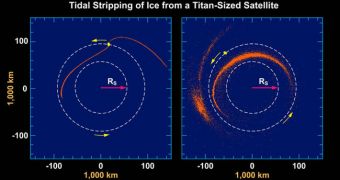A team of astronomers challenges the established idea that Saturn's massive rings formed when a comet passed too close to the planet, or when such a body struck one of its moons. The new idea holds that the structures appeared as a result of a collision between Saturn and a very large moon.
The group believes that, in order for a natural satellite to create such outcomes, it would have had to be at least the size and mass of Titan, currently the largest moon around Saturn. The rings are basically the final shards of the ancient collision.
According to the new calculations, the collision took place an estimated 4.5 billion years ago, when events conspired to see the large moon spiraling towards its parent planet. As it did so, gravity began exerting its effects on the celestial body.
Astronomers now think that most of this object was made of ice, which is not impossible, if considering the Saturnine moon Enceladus and Jupiter's Europa, Space reports.
As such, during its final approach to Saturn, strong gravity began destabilizing its structure, eventually forcing it to shed its icy, outer layers, which were mostly made up of ice.
The researchers say that the rings we see today are in fact pieces of what was once the surface of this Titan-sized moon. This model also helps explain the chemical composition of the circular structures.
What made it difficult for planetary scientists to propose explanations for how the rings formed was precisely their chemical composition, as the formations have a water-ice content of 90 to 95 percent.
Given that contamination occurs over time, experts believed it was safe to say that all of them were made of pure water-ice when they first appeared. Only two explanations for their existence were seriously considered among scientists.
One holds that the rings appeared following a collisions between a comet and a Saturnine moon, while the other says that they were formed after the planet's gravity ripped apart a comet that came too close.
The new model “implies that the rings are primordial, that they formed from the same processes that left Titan as Saturn's only large satellite,” explains investigator Robin Canup.
“And it's the only self-consistent explanation for the ice-rich inner satellites,” adds the expert, who was the author of the new study. She holds an appointment at the Southwest Research Institute (SwRI), in Boulder, Colorado.
“Other theories have struggled to explain an initial ring that was essentially pure ice. That's a very unusual composition,” the expert goes on to say.
The existence of another Titan-sized moon is supported by the fact that Jupiter has four large moons rather than one. Saturn may have had more than one or two in its heyday as well.
One of the most important consequences of this idea is the fact that it provides an explanation for the very existence of the gas giant's icy inner moons, which standard models cannot readily explain.
Tethys, Enceladus and Mimas are all good examples of such bodies. They may have formed as ice particles from the rings started moving outwards. Those that moved inwards were “eaten” by Saturn.
“The other theories have the rings forming from a sort of random event. This model reduces the number of things that have to happen, which I think makes it more probable,” Canup explains.
Details of the new investigation appear in the December 12 online issue of the esteemed scientific journal Nature.

 14 DAY TRIAL //
14 DAY TRIAL //